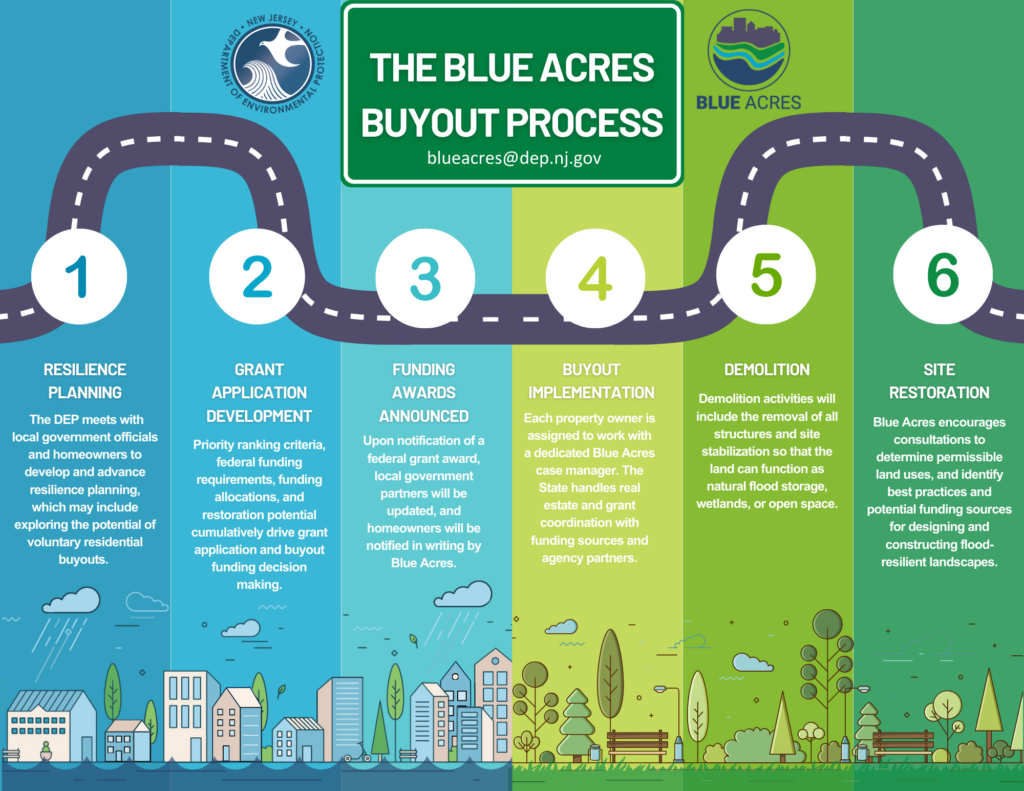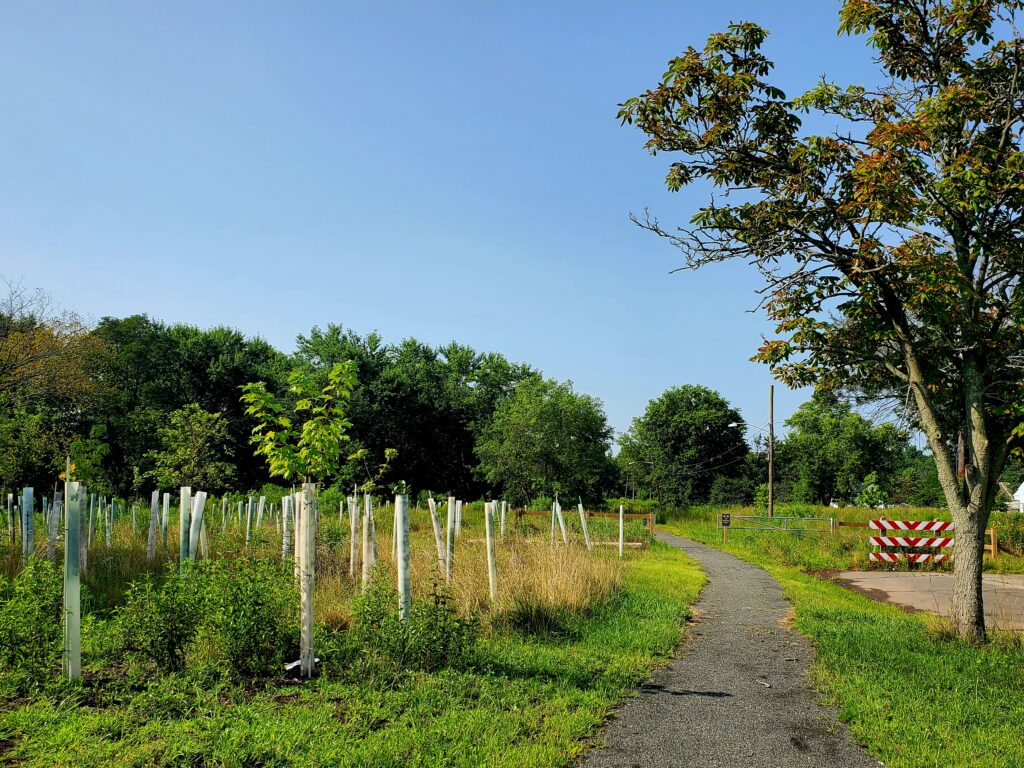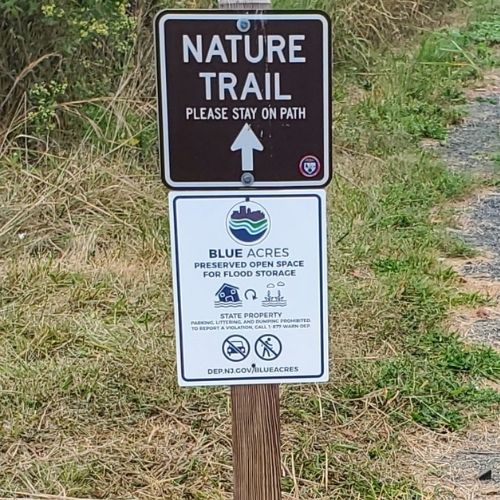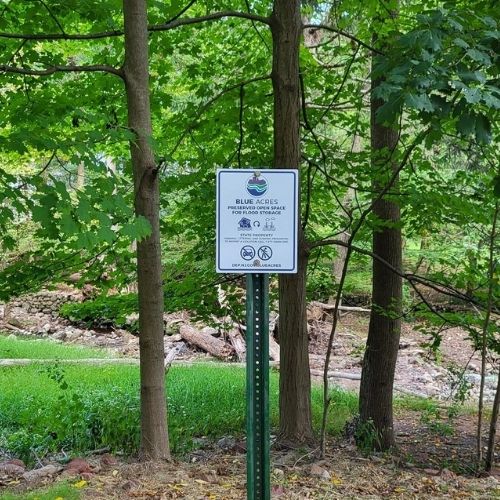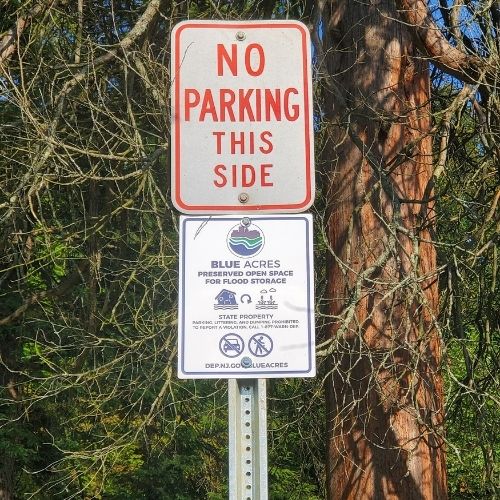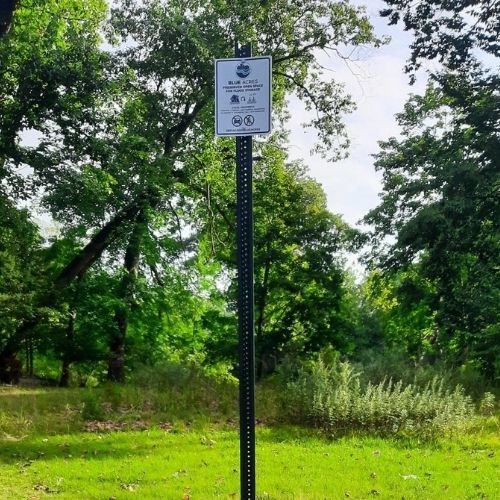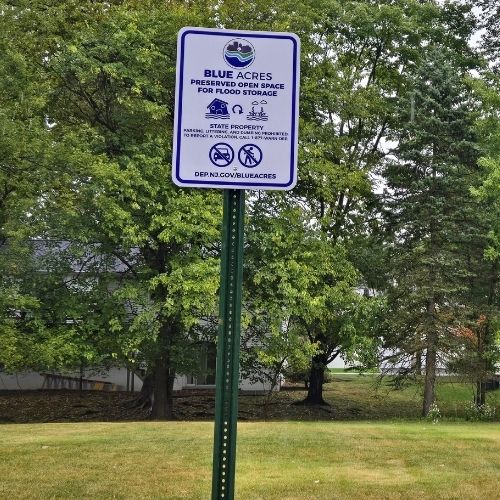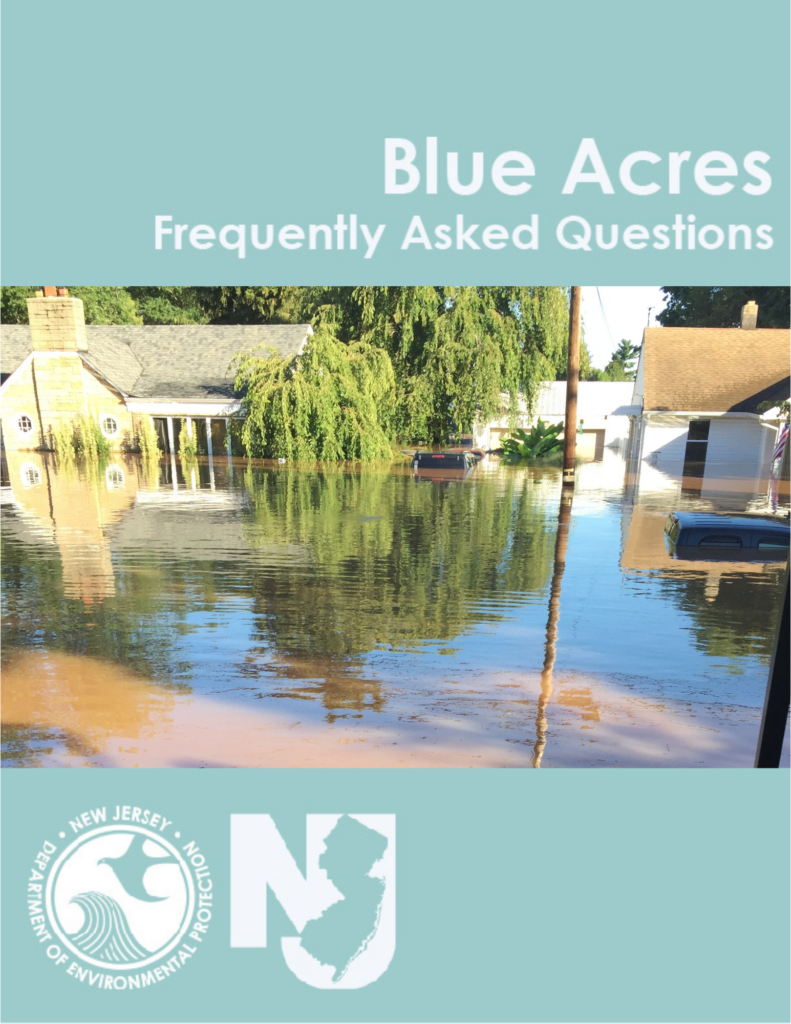
Information for Local Governments
Buyouts are a valuable tool as part of your community’s climate resilience strategy; start preparing your community for the mounting impacts of climate driven flooding now.
Local governments work with Blue Acres throughout the buyout process and as trusted partners beyond the initial buyout phase:
- providing local expertise and insight to inform and guide community-level buyout planning;
- explaining and messaging local floodplain regulations to owners;
- facilitating outreach to residents and local homeowners in need of recovery and mitigation options (share this flyer with homeowners who need flood buyout information in English or Spanish);
- providing substantial damage letters, property record cards, and other supporting documentation to state buyout staff during the process of applying for federal grant funds;
- serving as custodial manager for acquired lands through a legal delegation agreement; and
- helping the local community envision the transformation of residential lots into functioning floodplains and community amenities consistent with open space preservation.
Post-acquisition land use
How can communities transform vacant flood-prone properties, to create community amenities and optimize floodplain functionality?
Blue Acres properties are designated as “open space,” meaning the land can only be used for passive recreation, wetlands, habitat, or flood-storage purposes. For an overview of natural floodplain function, authorized uses of Blue Acres properties, and managing encroachments on State-owned lands, check out the Blue Acres Post-Buyout Land Management Field Guide. As regulations surrounding State-owned land use are modified, Blue Acres will provide updates.
“Creating Flood-Resilient Landscapes: A Primer for New Jersey Communities” is a resource guide that can help municipal leaders plan, design, and implement flood resilience projects on Blue Acres parcels (as well as any flood-prone open space).
The use or adaptation of NJDEP lands by a public or private entity, whether permanent or temporary, requires specific permission from the NJDEP. Although NJDEP lands can serve many purposes, certain uses conflict with or are incompatible with the NJDEP’s mission.
To request a change in use for a NJDEP property, interested parties can submit a Request for Use of NJDEP Property Form. Please be sure to indicate Blue Acres involvement and your program contact, if applicable, in Section V. Project History.
Identify Blue Acres Properties in Your Community
Disclaimer: The embedded web map was developed by Rutgers University student Nirupama Vidyarthi, using publicly available open-space data. It is being shared on the Blue Acres website while we advance our web mapping application. This student-created mapping can assist in identifying Blue Acres state-owned buyout lands, but full data accuracy is not guaranteed. Please be advised that this web map is intended for informational purposes only and should not be considered authoritative for legal or regulatory purposes.
Please note:
- This Webmap/Webapp was developed using New Jersey Department of Environmental Protection Geographic Information System digital data, but this secondary product has not been verified by NJDEP and is not state-authorized or endorsed.
- Some locally-acquired flood buyout lands may not be displayed on this map.
- Management of state-owned buyout lands is often formally delegated to a local government, which may not always be reflected in the Management Type/Manager data.
- Recent buyouts may not be represented on this map since data updates are done periodically.
- Users are encouraged to verify all information independently with public records and consult with Blue Acres staff if questions arise.
Having trouble viewing the web map on this page?
Click the button below to access the web map in a new window.
Signage on Blue Acres Land
To enhance community resilience and flood preparedness, Blue Acres program signage raises local awareness about ongoing flood hazards and home buyouts as a permanent mitigation solution. These signs are not meant to demark each individual buyout property; they are designed mainly to:
- increase public awareness of the Blue Acres program,
- highlight local flood risks,
- aid in local management of State owned lands by informing the public about prohibited activities and providing a contact for enforcement concerns.
Request Signs
Local land managers play a crucial role in maintaining these spaces long-term in a manner that meets community goals and is consistent with floodplain conservation and functionality. Local land managers, including local units of government and non-profit organizations may request Blue Acres signage to install on State owned land under their management purview.
To request signs or learn more, contact the Blue Acres program at BlueAcres@dep.nj.gov.
Frequently Asked Questions by Local Government Officials
Is my municipality eligible for buyouts?
Buyouts can occur in any community that struggles with flooding in residential areas. DEP Blue Acres evaluates storm-impacted and flood-prone communities throughout the state on an ongoing basis. Any area or neighborhood that meets these criteria is eligible for Blue Acres assistance, regardless of whether the flooding is coastal or inland. Keep in mind that Federal buyout funding can be more selective, and typically available only to specific geographies. For example, FEMA’s Flood Mitigation Assistance (FMA) program funding is available only to communities participating in, and in good standing with, the National Flood Insurance Program (NFIP).
What properties are eligible?
Currently, only privately-owned residential properties are eligible for the buyout program. Blue Acres continues to work with state and local officials to proactively reduce flood risk and the inequities that adversely affect the communities most vulnerable to climate change. All homeowners must be willing sellers and there is no requirement for clusters or neighborhood-wide participation for a community to begin dialogue with Blue Acres about buyouts.
Blue Acres will notify local governments if properties within their jurisdiction are eligible upon request.
Will it cost my municipality to participate in flood mitigation via State-led buyouts?
No. The administrative costs to implement buyouts are borne by DEP; this includes covering the costs of property appraisals, property closings, environmental reviews, and demolitions. The State seeks to minimize costs for local governments involved in Blue Acres.
Once a property’s deed has been transferred to DEP, the State retains legal ownership. DEP encourages local governments to take an active role in stewarding these newly created open spaces post-demolition; Blue Acres welcomes local partnerships with environmental groups and nonprofits.
Where do local governments fit into the Blue Acres buyout planning process?
Identifying at-risk neighborhoods/areas for future buyouts before disaster strikes: Planning where buyouts or elevations make sense ahead of the next storm or flood will lessen the costs of recovery and can expedite the rebuilding process so that community and economic vitality are restored faster.
Promoting proactive community-level buyout planning: To address the impacts of climate-driven flooding, municipalities can promote local buyout planning and improve local flood resilience by:
- Increasing public awareness of local flood risks;
- Emphasizing the benefits of having flood insurance;
- Adopting and implementing floodplain management regulations;
- Encouraging responsible building practices;
- Promoting flood risk awareness among vulnerable populations (elderly, disableD, residents with limited English proficiency);
- Making information about Blue Acres readily available, especially leading up to Hurricane season or in the immediate aftermath of a flood event.
Where do local governments fit into the Blue Acres buyout implementation process?
Information sharing: Local governments serve as a valuable source of buyout information to their residents, though homeowners are always welcome to contact Blue Acres directly. Blue Acres will notify local governments if federal buyout funding has been proposed and approved within their jurisdiction. Blue Acres works directly with homeowners to guide them through the buyout implementation steps such as appraisal, site inspections, title, etc.
Property-specific problem-solving: Although not common, Blue Acres may reach out to local government contacts to troubleshoot unique, case-specific impediments to buyout progress. For example, unsafe structures that can’t be entered for inspection purposes would need to be formally declared unsafe before inspection requirements could be waived.
Open House events: At the debut of the buyout implementation process, after federal buyout funds are awarded, Blue Acres holds local Open House events where approved participating homeowners are invited to meet Blue Acres buyout staff, including their assigned case managers. Local government officials are invited to Open House events to provide localized resources to the homeowners in their jurisdiction. Local government representatives might include elected officials, floodplain managers, construction officials, etc. Beyond the Open House, local government officials are welcome to seek project status updates.
Where do local governments fit into the Blue Acres post-buyout process?
Post-buyout demolition: After a property owner has conveyed title to the State, Blue Acres is typically responsible for demolition activities which include removal of structures and utilities and stabilizing the land through seeding and regrading. In cases where more than five properties are to be demolished, a contractor will likely be procured by NJDEP in coordination with NJ Treasury’s Division of Property Management and Construction. In cases where a few properties to be demolished, Blue Acres hopes to explore the potential of conveying a portion of the property’s ownership interest to the local government to allow for the administration of demolition activities through local procurement. This approach will be used on a case-by-case basis when mutually beneficial.
Post-demolition custodial management: After NJDEP’s closing with the homeowner and demolition work is complete, the local government continues to promote public safety by hindering trespassers and illegal activities on the land. It is the goal of the program that these sites, while owned by the State, serve to benefit the local community by reducing flood risk and creating public open space. As such, Blue Acres encourages local governments to take an active role in organizing the community to conceptualize beneficial uses for the land’s long-term management.
What can local governments do with the land?
Local governments can create community amenities and enhance flood resilience through restoration. While the State retains ownership of Blue Acres-acquired land, municipalities are encouraged to take an active stewardship role of the site(s), working closely with State partners to envision and realize meaningful restoration and transformation of flood-prone lands into community amenities.
Blue Acres properties are designated as “open space,” meaning the land can only be used for passive recreation, wetlands, habitat, or flood storage purposes. To serve the intended function as a restored floodplain, structural options are limited at a Blue Acres site so as not to impede the flow of floodwaters.
Funding for post-demolition restoration work is available through various public and private sources, including public-private partnerships. Restoration project costs can also be minimized with the help of volunteers who can help with project installations such as vegetative plantings, maintaining unpaved trails, or creating community gardens.
Generally allowed uses (with appropriate approvals): Unpaved multi-use paths and small-scale recreational fields; Unwalled structures, such as gazebos, pavilions, or picnic shelters; Small boat ramps, docks, or piers to serve public recreational use; Vegetative site stabilization, including planting native tree saplings or use as a small-scale community garden; Installation of informative signs (designed not to trap debris).
Some prohibited uses are: Walled buildings; Fixed flood control structures (i.e., levees, berms, floodwalls); Fences that may obstruct the floodway (fences outside the floodway must be designed to minimize the trapping of debris); Cemeteries, landfills, or storage of hazardous materials; Paved roads or parking areas.
What are the benefits of open space?
Open space improves community climate resilience. For the purposes of Blue Acres, “open spaces” are restored floodplains that are eligible for community use while remaining undeveloped. In addition to the natural flood and erosion control provided by these spaces, they promote groundwater recharge, filter pollutants, and provide valuable wildlife habitat. Natural floodplains help reroute and contain floodwaters, minimizing damage to nearby properties. In the long term, public green spaces such as these are known to improve quality of life for the locals, provide educational and ecotourism opportunities, and can improve nearby property values in their capacity as an attractive community amenity. Did you know, per FEMA, that one acre of floodplain stores 330,000 gallons of water?
